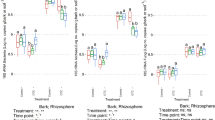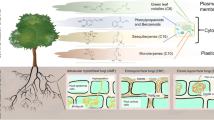Abstract
Successful host plant colonization by tree-killing bark beetle-symbiotic fungal complexes depends on host suitability, which is largely determined by host defense metabolites such as monoterpenes. Studies have shown the ability of specific blends of host monoterpenes to influence bark beetles or their fungal symbionts, but how biologically relevant blends of host monoterpenes influence bark beetle-symbiotic fungal interaction is unknown. We tested how interactions between two host species (lodgepole pine or jack pine) and two fungal symbionts of mountain pine beetle (Grosmannia clavigera or Ophiostoma montium) affect the performance of adult female beetles in vitro. Beetles treated with the propagules of G. clavigera or O. montium or not treated (natural fungal load) were introduced into media amended with a blend of the entire monoterpene profile of either host species and beetle performance was compared. Overall, host blends altered beetle performance depending on the fungal species used in the beetle amendment. When beetles were amended with G. clavigera, their performance was superior over beetles amended with O. montium in either host blend. Furthermore, G. clavigera-amended beetles performed better in media amended with host blends than without a host blend; in contrast, O. montium-amended beetles performed better in media without a host blend than with a host blend. Overall, this study showed that host defense metabolites affect host suitability to bark beetles through influencing their fungal symbionts and that different species of fungal symbionts respond differentlly to host defense metabolites.



Similar content being viewed by others
Data Availability
Data will be available upon acceptance of the manuscript.
References
Abràmoff MD, Magalhães PJ, Ram SJ (2004) Image processing with ImageJ. Biophoton. Int. 11:36–42
Behmer ST, Nes DW (2003). Insect sterol nutrition and physiology: a global overview in Adv Ins Physiol 31:1072
Bleiker KP, Six DL (2007) Dietary benefits of fungal associates to an eruptive herbivore: potential implications of multiple associates on host population dynamics. Environ. Entomol. 36:1384–1396
Bleiker KP, Potter SE, Lauzon CR, Six DL (2009) Transport of fungal symbionts by mountain pine beetles. Can. Entomol. 141:503–514
Cale JA, Collignon RM, Klutsch JG, Kanekar SS, Hussain A, Erbilgin N (2016) Fungal volatiles can act as carbon sources and semiochemicals to mediate interspecific interactions among bark beetle-associated fungal symbionts. PLoS One 11(9):e0162197
Cale JA, Muskens M, Najar A, Ishangulyyeva G, Hussain A, Kanekar SS, Klutsch JG, Taft S, Erbilgin N (2017) Rapid monoterpene induction promotes the susceptibility of a novel host pine to mountain pine beetle colonization but not to beetle-vectored fungi. Tree Physiol. 37:1597–1610
Cale JA, Klutsch JG, Dykstra CG, Peters B, Erbilgin N (2019a) Pathophysiological responses of pine defensive metabolites largely lack differences between pine species but vary with eliciting ophiostomatoid fungal species. Tree Physiol. 39:1121–1135
Cale JA, Ding R, Wang F, Rajabzadeh R, Erbilgin N (2019b) Ophiostomatoid fungi can emit the bark beetle pheromone verbenone and other semiochemicals in media amended with various pine chemicals and beetle-released compounds. Fungal Ecol. 39:285–295
Chiu CC, Keeling CI, Bohlmann J (2017) Toxicity of pine monoterpenes to mountain pine beetle. Sci. Rep. 7:8858
DiGuistini S, Wang Y, Liao NY, Taylor G, Tanguay P, Feau N et al (2011) Genome and transcriptome analyses of the mountain pine beetle-fungal symbiont Grosmannia clavigera, a lodgepole pine pathogen. PNAS 108:2504–2509
Erbilgin N (2019) Phytochemicals as mediators for host range expansion of a native invasive forest insect herbivore. New Phytol. 221:1268–1278
Erbilgin N, Ma C, Whitehouse C, Shan B, Najar A, Evenden M (2014) Chemical similarity between historical and novel host plants promotes range and host expansion of the mountain pine beetle in a naïve host ecosystem. New Phytol. 201:940–950
Erbilgin N, Cale JA, Hussain A, Ishangulyyeva G, Klutsch JG, Najar A, Zhao S (2017) Weathering the storm: how lodgepole pine trees survive mountain pine beetle outbreaks. Oecologia 184:469–478
Fang J, Liu M, Zhang S, Liu F, Zhang Z, Zhang Q, Kong X (2020) Complex chemical signaling interactions: a bark beetle-fungus symbiotic system and host/non-host trees. J. Exp. Bot. 71:6084–6091
Fox J, Weisberg S (2011) An R Companion to Applied Regression Second Thousand Oaks CA: Sage
Frago E, Dicke M, Godfray HCJ (2012) Insect symbionts as hidden players in insect-plant interactions. Trends Ecol. Evol. 27:705–711
Goodsman DW, Erbilgin N, Lieffers VJ (2012) The impact of phloem nutrients on overwintering mountain pine beetles and their fungal symbionts. Environ. Entomol. 41:478–486
Guevara-Rozo S, Hussain A, Cale JA, Klutsch JG, Rajabzadeh R, Erbilgin N (2020) Nitrogen and ergosterol concentrations varied in live jack pine phloem following inoculations with fungal associates of mountain pine beetle. Front. Microbiol. 11:1703
Hammerbacher A, Schmidt A, Wadke N, Wright LP, Schneider B, Bohlmann J, Brand W, Fenning TM, Gershenzon J, Paetz C (2013) A common fungal associate of the spruce bark beetle metabolizes the stilbene defenses of Norway spruce. Plant Physiol. 162:1324e1336
Hothorn T, Bretz F, Westfall P (2008) Simultaneous inference in general parametric models. Biom. J. 50:346–363
Ishangulyyeva G, Najar A, Curtis JM, Erbilgin N (2016) Fatty acid composition of novel host jack pine do not prevent host acceptance and colonization by the invasive mountain pine beetle and its symbiotic fungus. PLoS One 11:e0162046
Keeling CI, Bohlmann J (2006) Genes, enzymes and chemicals of terpenoid diversity in the constitutive and induced defence of conifers against insects and pathogens. New Phytol. 170:657–675
Krokene P (2015). Conifer defense and resistance to bark beetles,” in Bark Beetles: biology and ecology of native and invasive species. eds. F. E. Vega and R. W. Hofstetter (Amsterdam, The Netherlands: Elsevier Academic Press), 177–207
Lee S, Kim JJ, Breuil C (2006) Diversity of fungi associated with mountain pine beetle, Dendroctonus ponderosae, and infested lodgepole pines in British Columbia. Fun Div 22:91–105
Lieutier F, Yart A, Salle A (2009) Stimulation of tree defenses by Ophiostomatoid fungi can explain attack success of bark beetles on conifers. Ann. For. Sci. 66:801–801
Ojeda Alayon DI, Tsui CKM, Feau N, Capron A, Dhillon B, Zhang Y et al (2017) Genetic and genomic evidence of niche partitioning and adaptive radiation in mountain pine beetle fungal symbionts. Mol. Ecol. 26:2077–2091
Paine TD, Raffa KF, Harrington TC (1997) Interactions among scolytid bark beetles, their associated fungi, and live host conifers. Annu. Rev. Entomol. 42:179–206
Pinheiro J, Bates D, DebRoy S, Sarkar D, R Core Team (2018) nlme: linear and nonlinear mixed effects models. R package version 3.1–153. https://CRAN.R-project.org/package=nlme
R Core Team (2018) R: a language and environment for statistical computing. R Foundation for Statistical Computing, Vienna
Raffa KF, Aukema BH, Erbilgin N, Klepzig KD, Wallin KF (2005) Interactions among conifer terpenoids and bark beetles across multiple levels of scale: an attempt to understand links between population patterns and physiological processes. Recent Adv. Phytochem. 39:79–118
Reid ML, Sekhon JK, LaFramboise LM (2017) Toxicity of monoterpene identity, diversity, and concentration to mountain pine beetles, Dendroctonus ponderosae: beetle traits matter more. J. Chem. Ecol. 43:351–361
Rice A, Thormann MN, Langor D (2007a) Virulence of, and interactions among, mountain pine beetle associated blue-stain fungi on two pine species and their hybrids in Alberta. Can. J. Bot. 85:316–323
Rice AV, Thormann MN, Langor DW (2007b) Mountain pine beetle associated blue-stain fungi cause lesions on jack pine, lodgepole pine, and lodgepole × jack pine hybrids in Alberta. Can. J. Bot. 85:307–315
Roe AD, James PMA, Rice AV, Cooke JEK, Sperling FAH (2011) Spatial community structure of mountain pine beetle fungal symbionts across a latitudinal gradient. Microb. Ecol. 62:347–360
Six DL, Paine TD (1998) Effects of mycangial fungi and host tree species on progeny survival and emergence of Dendroctonus ponderosae (Coleoptera: Scolytidae). Environ. Entomol. 27:1393–1401
Tanin SM, Kandasamy D, Krokene P (2021) Fungal interactions and host tree preferences in the spruce bark beetle Ips typographus. Front. Microbiol. 12:695167
Therrien J, Mason CJ, Cale JA, Adams A, Aukema BH, Currie CR, Raffa KF, Erbilgin N (2015) Bacteria influence mountain pine beetle brood development through interactions with symbiotic and antagonistic fungi: implications for climate-driven host range expansion. Oecologia 179:467–485
Ullah A, Klutsch JG, Erbilgin N (2021) Production of complimentary defense compounds reflects a co-evolutionary arms race between a host plant and the mutualistic bark beetle-fungal complex. Plant Cell Environ. 44:3064–3077
Wang F, Cale JA, Erbilgin N (2020) Induced defenses of a novel host tree affect the growth and interactions of bark beetle-vectored fungi. Microb. Ecol. 80:181–190
Wang Y, Lim L, DiGuistini S, Robertson G, Bohlmann J, Breuil C (2012) A specialized ABC efflux transporter GcABC-G1 confers monoterpene resistance to Grosmannia clavigera, a bark beetle associated fungal pathogen of pine trees. New Phytol. 197:886–898
Wang Y, Lim L, Madilao L, Lah L, Bohlmann J, Breuil V (2014) Gene discovery for enzymes involved in limonene modification or utilization by the mountain pine beetle-associated pathogen Grosmannia clavigera. Appl. Environ. Microbiol. 80:4566–4576
Zhao T, Ganji S, Schiebe C, Bohman B, Weinstein P, Krokene P, Borg-Karlson AK, Unelius CR (2019a) Convergent evolution of semiochemicals across kingdoms: bark beetles and their fungal symbionts. ISME J 13:1535–1545
Zhao T, Kandasamy D, Krokene P, Chen J, Gershenzon J, Hammerbacher A (2019b) Fungal associates of the tree-killing bark beetle, Ips typographus, vary in virulence, ability to degrade conifer phenolics and influence bark beetle tunneling behaviour. Fun Ecol 38:71–79
Funding
This study was supported by NSERC-Discovery to NE.
Author information
Authors and Affiliations
Contributions
VA, JFC, and NE designed the experiment; VA, RZ, and GI developed protocols and conducted the experiment; NE and JFC analyzed the data; NE wrote the manuscript; all authors contributed to editing.
Corresponding author
Ethics declarations
Ethics Approval
Not applicable.
Consent to Participate
Not applicable.
Consent for Publication
Not applicable.
Competing Interests
The authors declare no competing interests.
Rights and permissions
About this article
Cite this article
Agbulu, V., Zaman, R., Ishangulyyeva, G. et al. Host Defense Metabolites Alter the Interactions between a Bark Beetle and its Symbiotic Fungi. Microb Ecol 84, 834–843 (2022). https://doi.org/10.1007/s00248-021-01894-6
Received:
Accepted:
Published:
Issue Date:
DOI: https://doi.org/10.1007/s00248-021-01894-6




